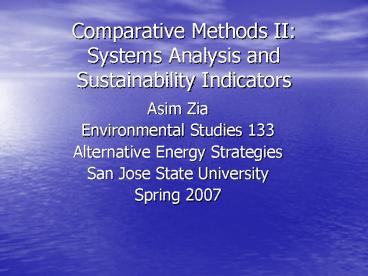Comparative Methods II: Systems Analysis and Sustainability Indicators - PowerPoint PPT Presentation
1 / 26
Title:
Comparative Methods II: Systems Analysis and Sustainability Indicators
Description:
Complex Systems Dynamics (Santa Fe Institute Studies in the Sciences of Complexity) (Paperback) ... 2004 Brooks/Cole Thomson Learning. 7-10 years. Poverty ... – PowerPoint PPT presentation
Number of Views:77
Avg rating:3.0/5.0
Title: Comparative Methods II: Systems Analysis and Sustainability Indicators
1
Comparative Methods II Systems Analysis and
Sustainability Indicators
- Asim Zia
- Environmental Studies 133
- Alternative Energy Strategies
- San Jose State University
- Spring 2007
2
Overview
- Complex Systems Dynamics
- Comparative Decision Algorithms
- Lifecycle analysis (covered in the last class)
- Simulation models
- Risk-based models
- Multiple Criteria Decision Making Models
- Fuzzy Models and Soft Systems
- Sustainability Indicators
3
Sustainability Amidst Complexity Complex Systems
Dynamics (CSD)
4
Trade-offs in Values and Goals
5
Some landmark books on CSD
- Complex Systems Dynamics (Santa Fe Institute
Studies in the Sciences of Complexity)
(Paperback) by Gerard Weisbuch - Business Dynamics Systems Thinking and Modeling
for a Complex World with CD-ROM by John Sterman
and John D. Sterman
6
Dynamics of Complex Systems (Studies in
Nonlinearity) by Yaneer Bar-Yam
- A central goal of this book is to develop models
and modeling techniques that are useful when
applied to all complex systems. This is done by
adopting both analytic tools, including
statistical mechanics and stochastic dynamics,
and computer simulation techniques, such as
cellular automata and Monte Carlo. In four sets
of paired, self-contained chapters, Yaneer
Bar-Yam discusses complex systems in the context
of neural networks, protein folding, living
organisms, and finally, human civilization
itself. He explores fundamental questions about
the structure, dynamics, evolution, development
and quantitative complexity that apply to all
complex systems.
7
Simulation models
- Aim at mathematically representing the system
being studied and simulating system operations
over time or under varying conditions or
scenarios - Examples
- National Energy Modeling System used by DOE to
forecast energy demand - IPCC to forecast global climate change under
various scenarios (including energy use)
8
National Energy Modeling Systemhttp//www.eia.doe
.gov/oiaf/aeo/overview/index.html
- Overall, NEMS represents the behavior of energy
markets and their interactions with the U.S.
economy. - The system reflects market economics, industry
structure, and existing energy policies and
regulations that influence market behavior.
9
National Energy Modeling System
10
NEMS Simulation Forecast
11
IPCC Simulation Frameworkwww.ipcc.ch
12
IPCC Scenario Simulations
13
IPCC Simulation Forecast
14
IPCC Simulation Forecast
15
IPCC Simulation Forecast
16
IPCC Simulation Forecast
17
IPCC 2001 simulation forecast
18
Risk Based Models
19
Hazard
Shortens average life span in the United States by
Poverty
7-10 years
Born male
7.5 years
Smoking
6-10 years
Overweight (35)
6 years
Unmarried
5 years
2 years
Overweight (15)
Spouse smoking
1 year
Driving
7 months
Air pollution
5 months
Alcohol
5 months
Drug abuse
4 months
Flu
4 months
AIDS
3 months
Air Pollution
2 months
Drowning
1 month
Pesticides
1 month
Fire
1 month
Natural radiation
8 days
5 days
Medical X rays
Oral contraceptives
5 days
Toxic waste
4 days
Flying
1 day
Hurricanes, tornadoes
1 day
Living lifetime near nuclear plant
10 hours
20
Multiple Criteria Decision Making Models
Cardinal Utility
- Simple Additive Weighting (SAW)
- Weighted Product
- TOPSIS
- ELECTRE
- Median Ranking Model
- Analytical Heirarchical Process (AHP)
21
Multiple Criteria Decision Making Models Ordinal
Utility
- Lexicographic Method
- Elimination by Aspect
- Conjunctive/Disjunctive Method
- Maximin and Maximax
- Dominance
22
MCDM (SAW method)
- Choose an alternative that maximizes Vi, for
i1,2,.m alternatives - Vi ?j1n wjrij
- Where wj is weighting function for j
attributes/criteria and rij is a normalized value
scale for ith alternative and jth criteria
23
Fuzzy Models and Soft Systems
- develop qualitative concepts to articulate ways
of thinking about complexity - Soft Systems provide an alternative to
mathematically-based concepts - Soft Systems Methodology in Action by Peter
Checkland, Jim Scholes - Soft Systems Methodology Conceptual Model
Building and Its Contribution by Brian Wilson
24
Sustainability Indicators
- Stock Indicators
- Flow Indicators
- Composite or synoptic indicators Indicators e.g.
ecological footprint, carbon footprint - Multiattribute indicators e.g. total national
capital TNC, Green GNP, - Distributional Indicators e.g. GINI coefficient
25
Carbon footprint of energy consumption as a
sustainability indicator
26
Carbon footprint (million tons/year)































